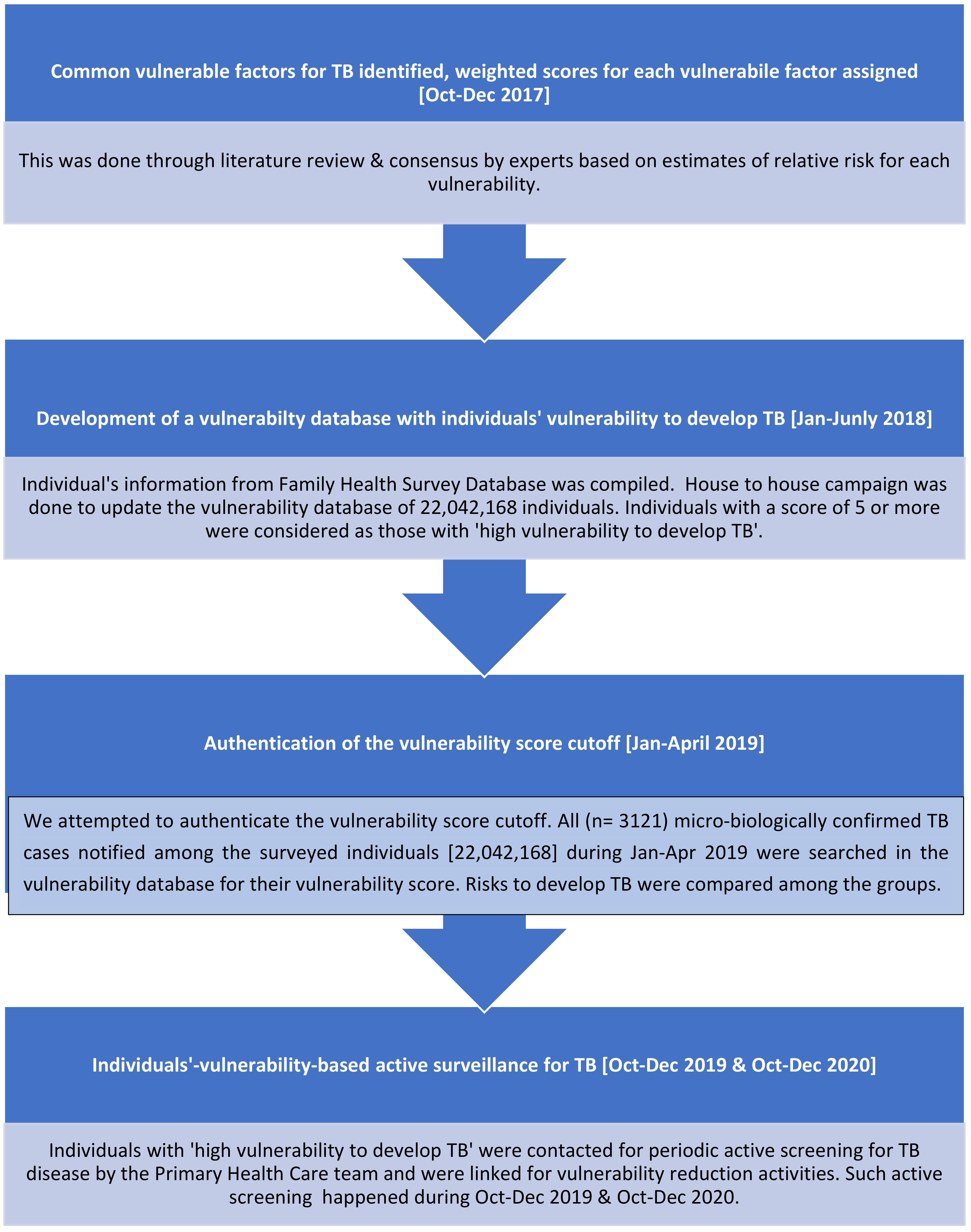Individuals’ Vulnerability Based Active Surveillance for TB: Experiences from India
Abstract
:1. Introduction
2. Materials and Methods
2.1. Concept
2.2. Process of Vulnerability Score Compilation
2.3. Authentication of the Vulnerability Score Cut-Off
2.4. Individuals’-Vulnerability-Based Active Surveillance for TB
3. Results
4. Discussion
5. Conclusions
Author Contributions
Funding
Institutional Review Board Statement
Informed Consent Statement
Data Availability Statement
Acknowledgments
Conflicts of Interest
References
- Central, T.B. Division. National Strategic Plan. 2012–2017. Available online: https://www.tbcindia.nic.in/WriteReadData/l892s/3525791619NSP%202012-2017.pdf (accessed on 25 October 2022).
- Bohlbro, A.S.; Hvingelby, V.S.; Rudolf, F.; Wejse, C.; Patsche, C.B. Active case-finding of tuberculosis in general populations and at-risk groups: A systematic review and meta-analysis. Eur. Res. J. 2021, 58, 2100090. [Google Scholar] [CrossRef] [PubMed]
- Biermann, O.; Lönnroth, K.; Caws, M. Factors influencing active tuberculosis case finding policy development and implementation: A scoping review. BMJ Open 2019, 9, 031284. [Google Scholar] [CrossRef] [PubMed]
- Government of Kerala. Economic Review 2017. In Proceedings of the Economic Review 2016. State Planning Board, Thiruvananthapuram, Kerala, India, March 2017. Available online: https://spb.kerala.gov.in/economic-review/ER2017/web_e/index.php (accessed on 25 October 2022).
- Government of Kerala. Kerala Health Conference- Making the SDG A Reality—Moving towards TB Elimination—4 March 2021. [Video Recording]. Thiruvananthapuram: GOK. 2021. Available online: https://www.youtube.com/watch?v=C4Yr_FTMdgQ&t=3452s (accessed on 24 October 2022).
- Government of India. Ministry of Health & Family Welfare (MOH), Central TB Division. India TB Report 2020. MOH. 2020. Available online: https://tbcindia.gov.in/showfile.php?lid=3538 (accessed on 23 October 2022).
- Rakesh, P.S.; Balakrishnan, S.; Mathew, M.E.; Mrithunjayan, S.; Manu, M.S. Population attributable risk of tuberculosis vulnerabilities in Kerala, India. Indian J. Commun. Med. 2020, 45, 367–370. [Google Scholar] [CrossRef] [PubMed]
- Balakrishnan, S.; Rakesh, P.S.; Viswanathan, K.; Nelson, V.; Simon, S.; Nair, S.A.; Mathew, M.E.; Sunilkumar, M. Higher risk of developing active TB among adult diabetics exposed to TB during childhood: A study from Kerala, India. J. Family Med. Prim. Care 2019, 8, 695–700. [Google Scholar] [CrossRef] [PubMed]
- Government of Kerala. Kerala TB Elimination Mission. August 2017. Available online: https://dhs.kerala.gov.in/wp-content/uploads/2021/01/KeralaTB-Elimination-Mission_Strategy-activity-plan-and-budget..pdf (accessed on 24 October 2022).
- Burugina Nagaraja, S.; Thekkur, P.; Satyanarayana, S.; Tharyan, P.; Sagili, K.D.; Tonsing, J.; Rao, R.; Sachdeva, K.S. Active Case Finding for Tuberculosis in India: A Syntheses of Activities and Outcomes Reported by the National Tuberculosis Elimination Programme. Trop. Med. Infect Dis. 2021, 6, 206. [Google Scholar] [CrossRef] [PubMed]
- Khobragade, R.N.; Kelkar, R.U.; Sunilkumar, M.; Cency, B.; Murthy, N.; Surendran, D.; Rakesh, P.S.; Balakrishnan, S. Health system resilience: Ensuring TB services during COVID-19 pandemic in Kerala, India. Indian J. Tuberc. 2022, 69, 427–431. [Google Scholar] [CrossRef] [PubMed]

| Vulnerability Groups | Total Number of Individuals (a) (Mapped during Jan–July 2018) | Out of (a), Number Developed Microbiologically Confirmed TB Disease Cases (Routine Program Data Jan–April 2019) | RR (95% CI) |
|---|---|---|---|
| Low vulnerability to the development of TB (score of 0) | 17,905,748 (81.2%) | 824 (26.4%) | 1 |
| Moderate vulnerability to the development of TB (scores 1–4) | 3,360,618 (15.3%) | 743 (23.8%) | 4.8 (4.3–5.3) |
| High vulnerability to the development of TB (scores ≥ 5) | 775,802 (3.5%) | 1554 (49.8%) | 43.4 (39.9–47.2) |
| Total | 22,042,168 | 3121 |
| Population-Based ACF in 2018 | ACF among Individuals with High Vulnerability * to the Development of TB in 2019 | ACF among Individuals with High Vulnerability * to the Development of TB in 2020 | |
|---|---|---|---|
| A. Total population of the state | 34,411,267 | 34,545,868 | 34,678,294 |
| B. Total individuals mapped for screening for TB | 1,600,000 | 775,802 | 976,147 |
| C. Out of (B), total individuals screened | 1,139,200 (71.2%) | 537,371 (69.3%) | 547,262 (56%) |
| D. Out of (C), total presumptive pulmonary TB cases identified | 46,707 (4.1%) | 30,900 (5.7%) | 28,457 (5.2%) |
| E. Out of (D), total tested for TB | 34,096 (73%) | 23,585 (76.3%) | 21,058 (74%) |
| F. Out of E, total microbiologically confirmed pulmonary TB case diagnosed | 302 (0.9%) | 610 (2.6%) | 558 (2.6%) |
| G. Number needed to test to detect one microbiologically confirmed pulmonary TB case (NNT) | 112 | 39 | 38 |
| H. Number needed to screen to diagnose one microbiologically confirmed pulmonary TB case (NNS) | 3772 | 881 | 980 |
| I. Microbiologically confirmed pulmonary TB cases diagnosed through ACF as a proportion of total microbiologically confirmed pulmonary TB cases in the state during the concerned period | 7.1% | 18.3% | 16.2% |
Publisher’s Note: MDPI stays neutral with regard to jurisdictional claims in published maps and institutional affiliations. |
© 2022 by the authors. Licensee MDPI, Basel, Switzerland. This article is an open access article distributed under the terms and conditions of the Creative Commons Attribution (CC BY) license (https://creativecommons.org/licenses/by/4.0/).
Share and Cite
Balakrishnan, S.K.; Suseela, R.P.; Mrithyunjayan, S.; Mathew, M.E.; Varghese, S.; Chenayil, S.; Aloysius, S.; Prabhakaran, T.; Nair, S.A. Individuals’ Vulnerability Based Active Surveillance for TB: Experiences from India. Trop. Med. Infect. Dis. 2022, 7, 441. https://doi.org/10.3390/tropicalmed7120441
Balakrishnan SK, Suseela RP, Mrithyunjayan S, Mathew ME, Varghese S, Chenayil S, Aloysius S, Prabhakaran T, Nair SA. Individuals’ Vulnerability Based Active Surveillance for TB: Experiences from India. Tropical Medicine and Infectious Disease. 2022; 7(12):441. https://doi.org/10.3390/tropicalmed7120441
Chicago/Turabian StyleBalakrishnan, Shibu K., Rakesh P. Suseela, Sunilkumar Mrithyunjayan, Manu E. Mathew, Suresh Varghese, Shubin Chenayil, Suja Aloysius, Twinkle Prabhakaran, and Sreenivas A. Nair. 2022. "Individuals’ Vulnerability Based Active Surveillance for TB: Experiences from India" Tropical Medicine and Infectious Disease 7, no. 12: 441. https://doi.org/10.3390/tropicalmed7120441
APA StyleBalakrishnan, S. K., Suseela, R. P., Mrithyunjayan, S., Mathew, M. E., Varghese, S., Chenayil, S., Aloysius, S., Prabhakaran, T., & Nair, S. A. (2022). Individuals’ Vulnerability Based Active Surveillance for TB: Experiences from India. Tropical Medicine and Infectious Disease, 7(12), 441. https://doi.org/10.3390/tropicalmed7120441






